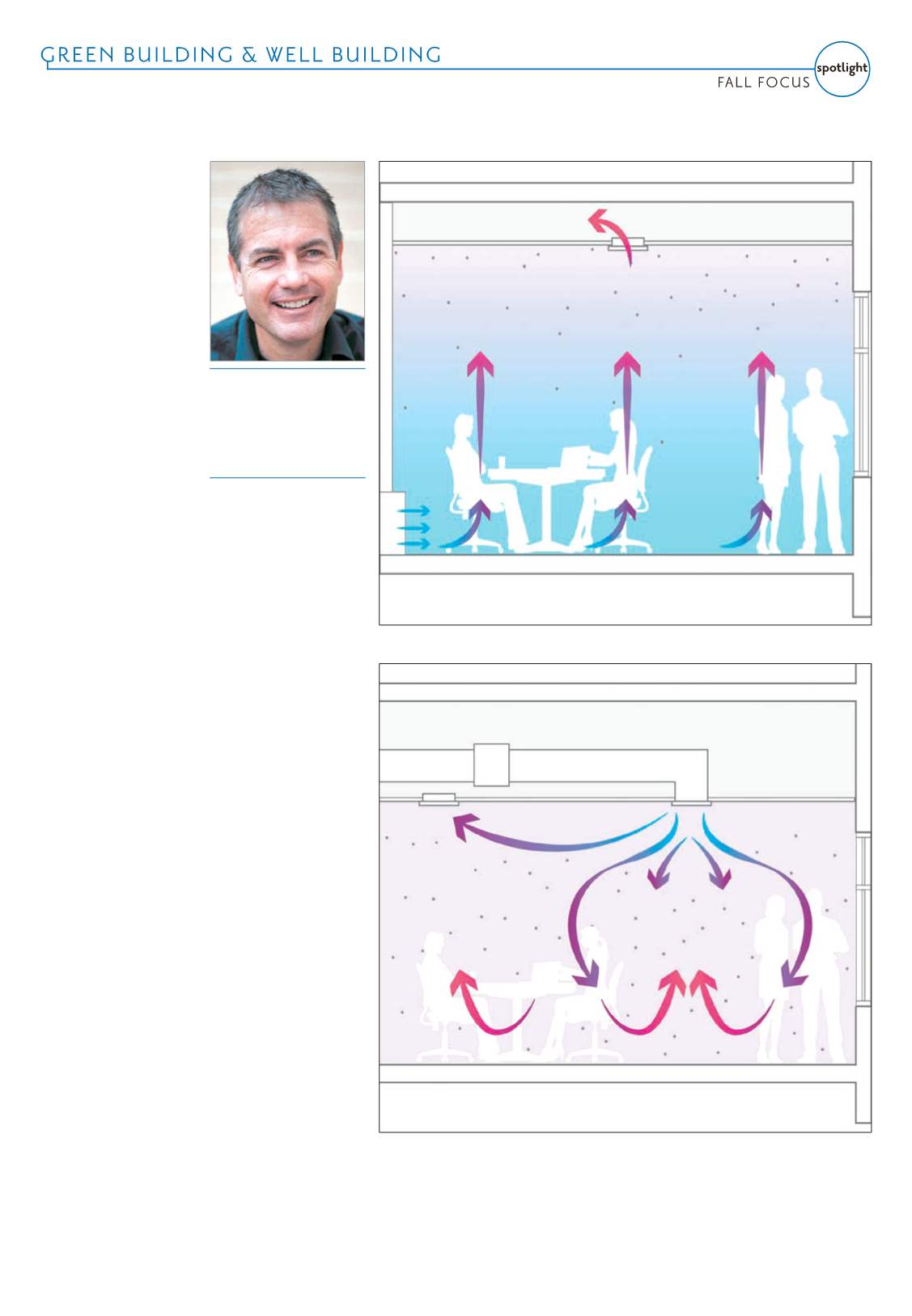
September 2-September 15, 2015
—
COLORADO REAL ESTATE JOURNAL
— Page 23B
B
uildings are not just
neutral environments to
shelter our activities and
protect our belongings. They have
a direct impact on our physiology
and our psyche. This means
that buildings are tools to help
us improve our health and well-
being. So if we can make people
better by making better buildings,
how do we make better buildings?
Conventional HVAC system design
is meant to deliver “acceptable” air
quality and “acceptable” thermal
comfort. How do we achieve
superior comfort and indoor air
quality while still lowering energy
use?
Let’s first look at conventional
building design and acceptable air
quality and comfort. One of the
most conventional HVAC systems
is the all-air, variable air volume
system. VAV systems combine
ventilation and space conditioning
into a single system and have
flexibility to address multiple
thermal zones. A significant
amount of air is required, because
the air is meant to condition the
space (about 80 percent of the
air), as well as ventilate it (about
20 percent of the air). All of this
air is cooled to 55 F, typically
delivered overhead, and to satisfy
the room setpoint the air in the
space needs to be well mixed.
VAV systems have cost effectively
addressed past conceptions of
acceptable air quality and comfort
for decades. However, with
growing expectations for superior
building performance, VAV
systems have several shortcomings:
Thermal comfort:
• Relies on air temperature
and convective transfer to
provide thermal comfort, but
human physiology strongly favors
radiant thermal exchanges for
maintaining comfort.
• Areas near the 55 F air supply
diffusers can have uncomfortable
cold spots when the diffusers are
not adequately specified.
Energy:
• The large volume of air
requires significant fan energy.
• The large volume of air
is cooled to 55 F, requiring
significant cooling energy.
• When heating is required
the air is “reheated” after being
cooled to 55 F.
Indoor air quality:
• Varies the air delivered based
on meeting space temperature
setpoints, making it uncertain
if ventilation requirements are
always met.
• The fully mixed air approach
inadvertently circulates
contaminants and airborne
pathogens throughout the space
and into the breathing zone.
• Recirculated return air
can potentially reintroduce
contaminants back into the
space.
A new approach to building
design is emerging, which pairs
methodical control of thermal
loads and air contaminant
sources with next-generation
HVAC systems that break
from the all-air approach of
VAV and can deliver on the
ever-increasing performance
demands for exemplary energy
efficiency, high IAQ and
enhanced thermal comfort.
These next-generation HVAC
systems are characterized by
decoupling ventilation from
space conditioning using a
dedicated outdoor air system to
meet ventilation needs with 100
percent outside air.
In humid climates the DOAS
can also handle the latent loads,
leaving sensible cooling and
heating to be handled separately
with greater efficiency and
comfort. A DOAS-based system
is typically paired with an ultra-
efficient heating and cooling
system such as radiant, variable
refrigerant flow, geothermal
heat pumps or chilled beams.
These system combinations
also typically provide reduced
equipment footprint, reduced
noise and lower life cycle cost.
One of the high-performing
system combinations is pairing
DOAS with radiant slabs or
panels, and one of the best ways
to deliver the ventilation air is
through displacement ventilation
or underfloor air distribution.
From a performance
perspective, DOAS-based
systems provide many benefits to
building owners and occupants:
Thermal comfort:
• Depending on the terminal
system used moderate supply
temperatures do not create cold
spots at supply diffusers.
• Paired with radiant heating
and cooling, can provide
superior comfort through
radiant thermal transfer.
• Compatible with natural
ventilation allowing for the
thermal comfort (and energy)
benefits of a mixed-mode
system.
Energy:
• Reduced air volumes and
moderate supply temperatures
reduce cooling and heating
energy for tempering ventilation
air.
• Energy efficiency is
enhanced with energy recovery.
• Reduced air volume reduces
fan energy.
• Utilizing zone specific
demand control ventilation with
CO2 sensors can further reduce
energy use.
• Paired with a parallel system
for heating and cooling such
as radiant, VRF, water source
heat pumps or chilled beams
saves energy by moving heat
throughout the building with
water or refrigerant, which is a
much better thermal conductor
than air.
Indoor air quality:
• Ventilation air is not
recirculated buildingwide and
100 percent outside air is used.
• Air delivery is not tied
to space conditioning and
temperature setpoints, assuring
that ventilation requirements
are always met.
• Can be configured as
displacement ventilation or
UFAD. By delivering cool air
at the floor level and returning
warm air at the ceiling, the air
stratifies rather than mixes. This
means that the air moves in one
direction, removing, rather than
recirculating, any contaminants
or pathogens in the space.
Market drivers like LEED
and the new WELL Building
Standard are moving the
industry toward more
sustainable, healthy buildings
with lower energy use and
increased comfort and indoor
air quality. DOAS-based HVAC
systems, fully integrated with
architecture that controls
both thermal loads and air
contaminant sources, can help
the industry meet these ever
growing expectations. The next-
generation of building design
is poised to make people better
by making better buildings.
Tom Hootman,
AIA, LEEDAP BD+C,
Provisional WELL AP
Performance and design innovation
lead, MKK Consulting Engineers,
Denver
DOAS displacement ventilation with stratified air flow and removal of contaminants.
Traditional all-air VAV system with well-mixed air flow and mixing of contaminants.


